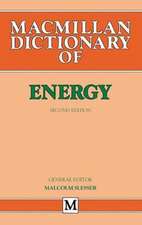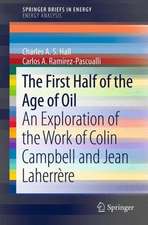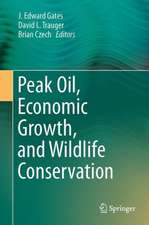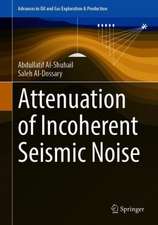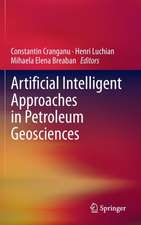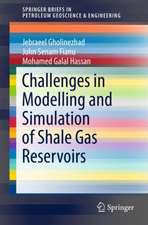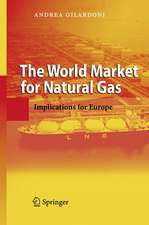Post-combustion CO2 Capture Technology: By Using the Amine Based Solvents: SpringerBriefs in Petroleum Geoscience & Engineering
Autor Helei Liu, Raphael Idem, Paitoon Tontiwachwuthikulen Limba Engleză Paperback – 6 oct 2018
This book presents a comprehensive review of the latest information on all aspects of the post-combustion carbon capture process. It provides designers and operators of amine solvent-based CO2 capture plants with an in-depth understanding of the most up-to-date fundamental chemistry and physics of the CO2 absorption technologies using amine-based reactive solvents. Topics covered include the physical properties, chemical analysis, reaction kinetics, CO2 solubility, and innovative configurations of absorption and stripping columns as well as information on technology applications.
This book also examines the post-build operational issues of corrosion prevention and control, solvent management, solvent stability, solvent recycling and reclaiming, intelligent monitoring and plant control including process automation. In addition, the authors discuss the recent insights into the theoretical basis of plant operation in terms of thermodynamics, transport phenomena, chemical reaction kinetics/engineering, interfacial phenomena, and materials.
The insights provided help engineers, scientists, and decision makers working in academia, industry and government gain a better understanding of post-combustion carbon capture technologies.
This book also examines the post-build operational issues of corrosion prevention and control, solvent management, solvent stability, solvent recycling and reclaiming, intelligent monitoring and plant control including process automation. In addition, the authors discuss the recent insights into the theoretical basis of plant operation in terms of thermodynamics, transport phenomena, chemical reaction kinetics/engineering, interfacial phenomena, and materials.
The insights provided help engineers, scientists, and decision makers working in academia, industry and government gain a better understanding of post-combustion carbon capture technologies.
Din seria SpringerBriefs in Petroleum Geoscience & Engineering
-
 Preț: 385.74 lei
Preț: 385.74 lei -
 Preț: 406.53 lei
Preț: 406.53 lei -
 Preț: 379.68 lei
Preț: 379.68 lei -
 Preț: 375.07 lei
Preț: 375.07 lei -
 Preț: 378.12 lei
Preț: 378.12 lei -
 Preț: 376.59 lei
Preț: 376.59 lei -
 Preț: 408.44 lei
Preț: 408.44 lei -
 Preț: 377.95 lei
Preț: 377.95 lei -
 Preț: 376.22 lei
Preț: 376.22 lei -
 Preț: 375.23 lei
Preț: 375.23 lei -
 Preț: 481.79 lei
Preț: 481.79 lei -
 Preț: 477.94 lei
Preț: 477.94 lei -
 Preț: 345.71 lei
Preț: 345.71 lei -
 Preț: 410.94 lei
Preț: 410.94 lei -
 Preț: 346.48 lei
Preț: 346.48 lei -
 Preț: 318.74 lei
Preț: 318.74 lei -
 Preț: 443.21 lei
Preț: 443.21 lei -
 Preț: 443.21 lei
Preț: 443.21 lei -
 Preț: 443.00 lei
Preț: 443.00 lei -
 Preț: 374.46 lei
Preț: 374.46 lei -
 Preț: 376.80 lei
Preț: 376.80 lei -
 Preț: 378.71 lei
Preț: 378.71 lei -
 Preț: 443.75 lei
Preț: 443.75 lei -
 Preț: 377.35 lei
Preț: 377.35 lei
Preț: 459.42 lei
Preț vechi: 540.49 lei
-15% Nou
Puncte Express: 689
Preț estimativ în valută:
87.92€ • 91.27$ • 73.31£
87.92€ • 91.27$ • 73.31£
Carte tipărită la comandă
Livrare economică 22 martie-05 aprilie
Preluare comenzi: 021 569.72.76
Specificații
ISBN-13: 9783030009212
ISBN-10: 3030009211
Pagini: 72
Ilustrații: VI, 51 p. 8 illus., 6 illus. in color.
Dimensiuni: 155 x 235 mm
Greutate: 0.1 kg
Ediția:1st ed. 2019
Editura: Springer International Publishing
Colecția Springer
Seria SpringerBriefs in Petroleum Geoscience & Engineering
Locul publicării:Cham, Switzerland
ISBN-10: 3030009211
Pagini: 72
Ilustrații: VI, 51 p. 8 illus., 6 illus. in color.
Dimensiuni: 155 x 235 mm
Greutate: 0.1 kg
Ediția:1st ed. 2019
Editura: Springer International Publishing
Colecția Springer
Seria SpringerBriefs in Petroleum Geoscience & Engineering
Locul publicării:Cham, Switzerland
Cuprins
Introduction and Background Information.- Solvent Property of Amine Based Solvent.- Design, Modeling and Simulation of Post Combustion CO2 Capture Systems Using Reactive Solvents.- Solvent Management.- Pilot and Demonstration Plants.- Conclusion and Summary.
Notă biografică
Dr Helei Liu is a researcher at the Clean Energy Technologies Research Institute at the Faculty of Engineering and Applied Science, University of Regina (SK, Canada). His research interests mainly involve new technologies for CO2 capture from flue gases from industrial sources, which also involve the development of reaction mechanisms and kinetics for CO2 capture based on new knowledge of CO2–amine interactions. He has published over 30 papers in international journals (AIChE J., Chem. Eng. J., Chem. Eng. Sci., Ind. Eng. Chem. Res., Applied Energy., Int. J. Greenhouse Gas Control, and Fuel) and given more than 10 presentations (key-note, oral and poster) at international conferences (Conference on Greenhouse Gas Control Technologies, annual AIChE meeting, International Conference on Gas–Liquid and Gas–Liquid–Solid Reactor Engineering).
Dr Paitoon Tontiwachwuthikul (known as P.T.) is currently a Full Professor at the Faculty of Engineering and Applied Science at the University of Regina, Canada, where he was the Dean from 1999 to 2013. He obtained his Ph.D. degree in Chemical Engineering from the University of British Columbia, Canada. Dr P.T. is the co-founder of the Clean Energy Technology Research Institute (previously known as the International Test Centre for CO2 Capture – ITC) in Canada. He is one of the main organizers of an international consortium on Low Carbon – Clean Energy Technologies, which includes international research organizations from Canada, Norway, China, Thailand, Turkey and Qatar. He is a key international researcher in the area of advanced CO2 capture and separation from industrial gas streams as well as low-carbon energy development, and has provided technical advice to governments and industries both nationally and internationally. Dr P.T. has played a vital role in the establishment of the Petroleum Technology Research Centre (PTRC), one of the largest petroleum research centers in North America.
Dr Raphael Idem obtained hisPh.D. in Chemical Engineering from the University of Saskatchewan, Saskatoon, Canada. He is a Full Professor of Engineering & Director of CETRI. Dr Idem has pursued extensive fundamental research on CO2 capture, with special interests in new technologies for CO2 mitigation and CO2 capture from exhaust gases from all industrial sources. His research also involves the development of reaction mechanisms and kinetics for CO2 capture based on new knowledge of CO2–amine interactions. Dr Idem has also conducted intensive and extensive research on CO2 utilization, especially that involving the use of waste materials to produce value-added products.
Dr Paitoon Tontiwachwuthikul (known as P.T.) is currently a Full Professor at the Faculty of Engineering and Applied Science at the University of Regina, Canada, where he was the Dean from 1999 to 2013. He obtained his Ph.D. degree in Chemical Engineering from the University of British Columbia, Canada. Dr P.T. is the co-founder of the Clean Energy Technology Research Institute (previously known as the International Test Centre for CO2 Capture – ITC) in Canada. He is one of the main organizers of an international consortium on Low Carbon – Clean Energy Technologies, which includes international research organizations from Canada, Norway, China, Thailand, Turkey and Qatar. He is a key international researcher in the area of advanced CO2 capture and separation from industrial gas streams as well as low-carbon energy development, and has provided technical advice to governments and industries both nationally and internationally. Dr P.T. has played a vital role in the establishment of the Petroleum Technology Research Centre (PTRC), one of the largest petroleum research centers in North America.
Dr Raphael Idem obtained hisPh.D. in Chemical Engineering from the University of Saskatchewan, Saskatoon, Canada. He is a Full Professor of Engineering & Director of CETRI. Dr Idem has pursued extensive fundamental research on CO2 capture, with special interests in new technologies for CO2 mitigation and CO2 capture from exhaust gases from all industrial sources. His research also involves the development of reaction mechanisms and kinetics for CO2 capture based on new knowledge of CO2–amine interactions. Dr Idem has also conducted intensive and extensive research on CO2 utilization, especially that involving the use of waste materials to produce value-added products.
Textul de pe ultima copertă
This book presents a comprehensive review of the most recent information available on all aspects of the post-combustion carbon capture process. It provides designers and operators of amine solvent-based CO2 capture plants with an in-depth understanding of the most up-to-date fundamental chemistry and physics of the CO2 absorption technologies using amine-based reactive solvents. Topics covered include physical properties, chemical analysis, reaction kinetics, CO2 solubility, and innovative configurations of absorption and stripping columns as well as information on technology applications.
Post-Combustion CO2 Capture Technology also covers the post-build operational issues of corrosion prevention and control, solvent management, solvent stability, solvent recycling and reclaiming, intelligent monitoring and plant control including process automation. In addition, the authors discuss the most up-to-date insights related to the theoretical basis of plant operation in terms of thermodynamics, transport phenomena, chemical reaction kinetics/engineering, interfacial phenomena, and materials.
The insights provided will help engineers, scientists, and decision makers working in academia, industry and government gain a better appreciation of the post-combustion carbon capture technology.
The insights provided will help engineers, scientists, and decision makers working in academia, industry and government gain a better appreciation of the post-combustion carbon capture technology.
Caracteristici
Broadens reader’s understanding of available chemical CO2 absorption technologies Explains how to design, model, and simulate post-combustion carbon capture systems using reactive solvents Equips readers to manage the solvents through each phase of their use, including proper recycling and reclaiming procedures



